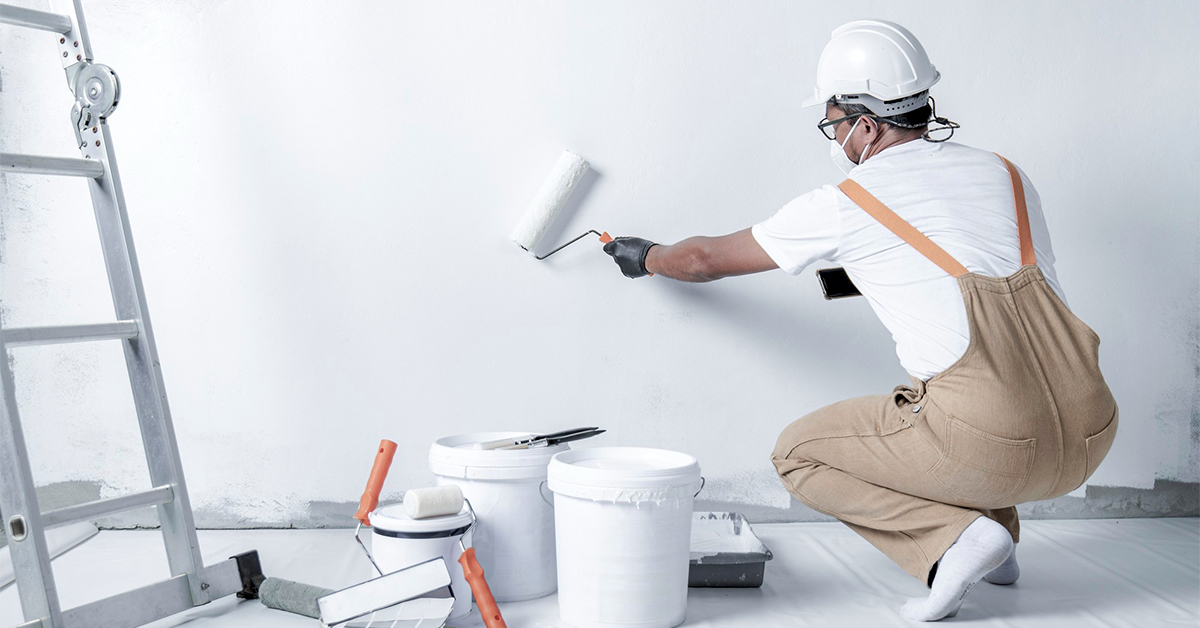benjamin moore paint store corpus christi Offers fade-resistant Paints for Every style
Discovering the Various Sorts Of Paint: A Guide for each Job
Discovering the various kinds of paint is crucial for attaining the preferred end result in any kind of job. From water-based choices that offer ease to oil-based paints understood for their durability, each option has its advantages. Specialty paints can include distinct structures or finishes, while green alternatives cater to those looking for sustainability. Comprehending these distinctions can greatly influence the success of a painting undertaking. What aspects should one consider when making the appropriate option?
Recognizing Paint Types: Oil-Based vs. water-based
Paint types can considerably influence a job's end result, and comprehending the distinctions between oil-based and water-based paints is vital for informed decision-making. Water-based paints, usually described as latex paints, are composed of water as the main solvent. They completely dry swiftly, produce less unstable organic substances (VOCs), and are simple to tidy up with soap and water. This makes them a prominent choice for indoor applications and atmospheres where air quality is a worry.
In contrast, oil-based paints make use of organic solvents, giving a long lasting, glossy coating suitable for surfaces exposed to tear and put on, such as trim and cupboards. They take longer to dry, call for mineral spirits for clean-up, and have a stronger odor. corpus christi paint store. Selecting in between these 2 types depends upon the details needs of the job, thinking about factors such as desired surface, application atmosphere, and simplicity of upkeep. Each kind has distinctive advantages and limitations, directing the option procedure
The Finish Matters: Selecting In Between Matte, Satin, and Gloss
When picking a paint finish, the option between matte and shiny choices substantially influences both aesthetic appeals and capability. Matte finishes provide a subtle, non-reflective look that can hide surface flaws, while glossy coatings provide sturdiness and convenience of cleansing. Understanding the benefits and considerations of each can assist in making an educated choice for any paint task.
Matte Finish Advantages
Many home owners question the values of various coatings, matte paint uses distinct benefits that make it a prominent choice for both indoor and exterior applications. Among the main advantages of matte surface is its ability to conceal surface blemishes, creating a smoother look on walls. This top quality is especially advantageous in older homes or rooms with uneven surface areas. Furthermore, matte paint soaks up light instead of mirroring it, which can enhance the visual of a room by giving a much more innovative and soft appearance. Matte surfaces are usually much easier to touch up than glossier alternatives, as they can blend more effortlessly when applied over existing paint. On the whole, matte paint is a superb option for those looking for a refined and classy surface.
Shiny Complete Considerations
A shiny finish can substantially alter the understanding of a space, supplying a smooth and reflective high quality that boosts both color vibrancy and light within an area. This surface is commonly preferred for high-traffic locations and surface areas like kitchens and restrooms, where longevity and ease of cleaning are important. Its reflective nature can highlight imperfections on walls, making appropriate surface prep work essential. Glossy paints likewise often tend to show fingerprints and smudges more readily, necessitating regular maintenance. Furthermore, lights plays a significant duty; in intense environments, a glossy surface might develop glow, influencing the overall visual. Cautious consideration of the particular application and environment is important when choosing a shiny surface for any task.
Specialized Paints: When to Make Use Of Distinctive or Chalk Paint
Specialized paints, such as textured and chalk paint, deal distinct aesthetic and practical benefits that can enhance different surface areas. Distinctive paint is suitable for producing depth and dimension on walls, hiding flaws while including a three-dimensional feeling. It is particularly useful in high-traffic areas where resilience and aesthetic rate of interest are necessary.

Both sorts of specialty paints can transform spaces, yet picking the ideal one depends upon the preferred impact and surface requirements. Distinctive paint might fit larger areas, while chalk paint can revitalize smaller sized things, showcasing creative thinking and individual design in any type of job.
Outside Paints: Safeguarding Your Surfaces From the Elements
Outdoor paints are essential for safeguarding surface areas versus different weather condition problems. Recognizing their climate resistance attributes, appropriate surface area prep work demands, and effective application strategies can considerably improve sturdiness and performance. This area will certainly describe key factors to consider for picking and utilizing outdoor paints effectively.
Climate Resistance Includes
Weather resistance is an important feature of exterior paints, as it establishes exactly how well surface areas can stand up to the extreme elements of nature. High-quality exterior paints are created to withstand damage from UV rays, dampness, and temperature level fluctuations. UV resistance guarantees shades continue to be dynamic with time, preventing fading and discoloration. Wetness resistance safeguards against mold and mold, which can endanger the integrity of surfaces. Furthermore, paints with superb temperature level resistance can broaden and contract without breaking, keeping their protective qualities. When choosing exterior paints, it is vital to take into consideration these weather condition resistance attributes, as they contribute to the longevity and longevity of painted surfaces, making sure they stay visually pleasing and useful regardless of direct exposure to the elements.
Surface Preparation Requirements
Appropriate surface preparation is an essential action in accomplishing the very best outcomes with exterior paints. To assure ideal adhesion and resilience, surfaces need to be completely cleansed, getting rid of dust, mold, and oil. This can be achieved utilizing a pressure washing machine or a scrub brush with an ideal cleansing solution. Once cleaned, surfaces ought to be evaluated for any peeling or flaking paint, which need to be scratched away to produce a smooth foundation. Fixing any kind of cracks or holes is additionally necessary, as these can permit moisture infiltration. Additionally, sanding rough areas promotes much better paint bond. Using a guide suited for outdoor use can boost the paint's performance, ensuring a durable finish that stands up to the aspects. Proper prep work is crucial to a successful exterior paint project.
Application Strategies Tips
While using outdoor paints, it is vital to utilize reliable methods that guarantee surface areas are well-protected against the components. Initially, choose the right day for paint; reduced moisture and mild temperature levels improve adhesion and drying out. Prepping the surface area extensively-- cleansing, fining sand, and priming-- guarantees better paint attachment and longevity. Making use of top notch brushes or rollers can offer a smoother coating, more info while spray paint might cover huge areas efficiently. Applying paint in slim, also layers stops drips and runs. It is advisable to adhere to maker directions concerning drying times in between coats. Finally, verify appropriate air flow throughout application to facilitate drying and lessen direct exposure to fumes. These strategies substantially enhance the longevity and efficiency of outside paint.
Eco-Friendly Options: Low-VOC and Zero-VOC Paints
As consumers end up being progressively conscious of the ecological effect of their options, zero-voc and low-voc paints have actually become prominent choices. These paints are developed to consist of less unstable organic compounds (VOCs), which are chemicals that can evaporate into the air and add to air pollution and health issue. Low-VOC paints generally include a limited amount of VOCs, while zero-VOC paints have minimal degrees, making them more secure for both interior and exterior use.
The benefits of using zero-voc and low-voc paints expand past environmental considerations; they also boost interior air high quality, decreasing the risk of sensitive responses and breathing problems. Lots of producers now offer a variety of shades and surfaces in eco-friendly alternatives, making it much easier for consumers to locate ideal products for their projects. By going with these paints, people can contribute to a healthier setting while still accomplishing the visual they prefer in their areas.
Tools and Strategies for a Perfect Application
Accomplishing a flawless paint application requires the right tools and strategies, which can substantially improve the final outcome. Selecting the proper brush or roller is necessary; brushes work well for sides and intricate locations, while rollers cover larger surfaces successfully. Using high-grade materials assures better paint circulation and minimizes streaks. For ideal results, surface area preparation is critical. This includes cleansing, sanding, and priming surfaces to advertise adhesion.
Method additionally plays a significant function. The "W" approach with a roller helps to uniformly disperse paint, while long, smooth strokes with a brush avoid noticeable lines. Operating in areas enables better control and mixing. In addition, applying thin layers is more effective to thick layers, lowering the threat of drips and uneven appearances. Maintaining a damp side throughout application helps achieve seamless changes between areas. By integrating these strategies and devices, one can attain a sleek and specialist finish.
Tips for Maintaining and Caring for Your Painted Surfaces
Proper maintenance and care of coloured surface areas can greatly prolong their life expectancy and protect their appearance. Regular cleaning is vital; utilizing a soft fabric or sponge with moderate soap and water can remove dust and dust without harming the paint. It is suggested to stay clear of unpleasant cleansers or scrubbing pads, as these can scratch the surface. In addition, using a fresh layer of paint every few years can protect and rejuvenate the shade versus wear.
For outside surfaces, inspecting for signs of peeling off or fading regularly is very important. Without delay resolving any kind of problems avoids further damages. In locations prone to dampness, such as washrooms, making use of mold-resistant paint and making sure proper air flow can assist maintain the integrity of the paint. Utilizing protective finishes can secure against UV rays and discolorations, guaranteeing that repainted surfaces continue to be vivid and appealing for years to come, eventually boosting the overall visual of the room.

Regularly Asked Concerns
Can I Mix Different Kind Of Paint Together?
Mixing various sorts of paint is usually not suggested, as it can cause problems like bad adhesion, inconsistent appearance, or unanticipated chemical responses. It's finest to use suitable paints for excellent outcomes and toughness.

Just how Do I Correctly Store Extra Paint?
To effectively store leftover paint, seal the container securely, tag it with the date and color, and keep it in a great, completely dry place away from direct sunlight and extreme temperature levels for excellent preservation.
What Is the most effective Method to Take Care Of Extra Paint?
The most effective way to throw away extra paint is to check local policies, as numerous areas have assigned harmful waste centers. Think about giving away useful paint to area companies or colleges for their jobs.
Exactly How Can I Tell if Paint Is Still Good to Use?
To determine if paint is still excellent, analyze its shade, smell, and consistency. If it shows up apart, has an unpleasant smell, or reveals considerable modifications in texture, it's likely no much longer useful.
Exist Age Restrictions for Getting Paint Products?
In lots of regions, there are no details age constraints for acquiring paint items. Nonetheless, some stores may call for clients to be a minimum of 18 years old, particularly for items having solvents or harmful materials.
Paint types can considerably influence a job's outcome, and recognizing the distinctions between water-based and oil-based paints is crucial for notified decision-making. Water-based paints, often referred to as latex paints, are made up of water as the primary solvent. In comparison, oil-based paints utilize organic solvents, giving a sturdy, glossy coating suitable for surface areas subjected to tear and wear, such as trim and closets. Specialty paints, such as distinctive and chalk paint, offer one-of-a-kind aesthetic and functional benefits that can improve numerous surfaces. In locations susceptible to moisture, such as bathrooms, utilizing mold-resistant paint and ensuring appropriate air flow can help preserve the honesty of the paint.